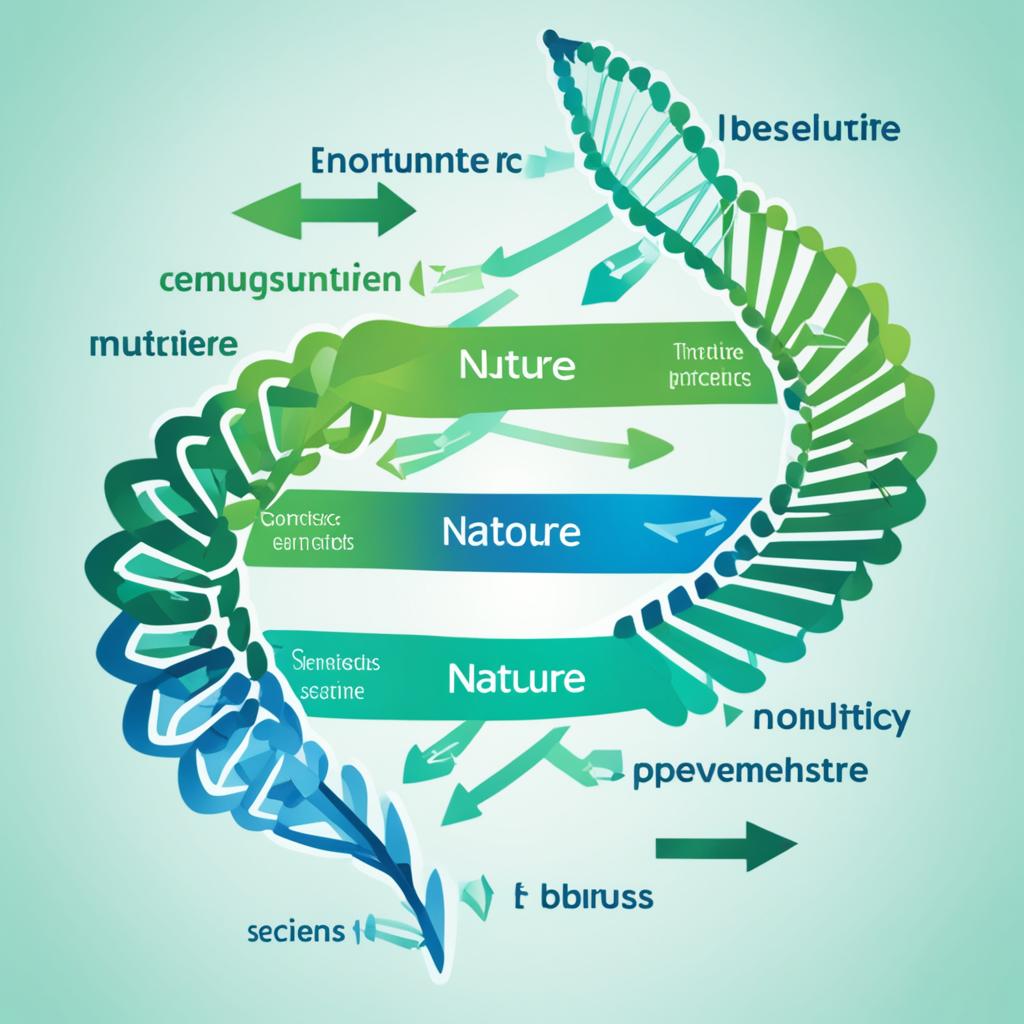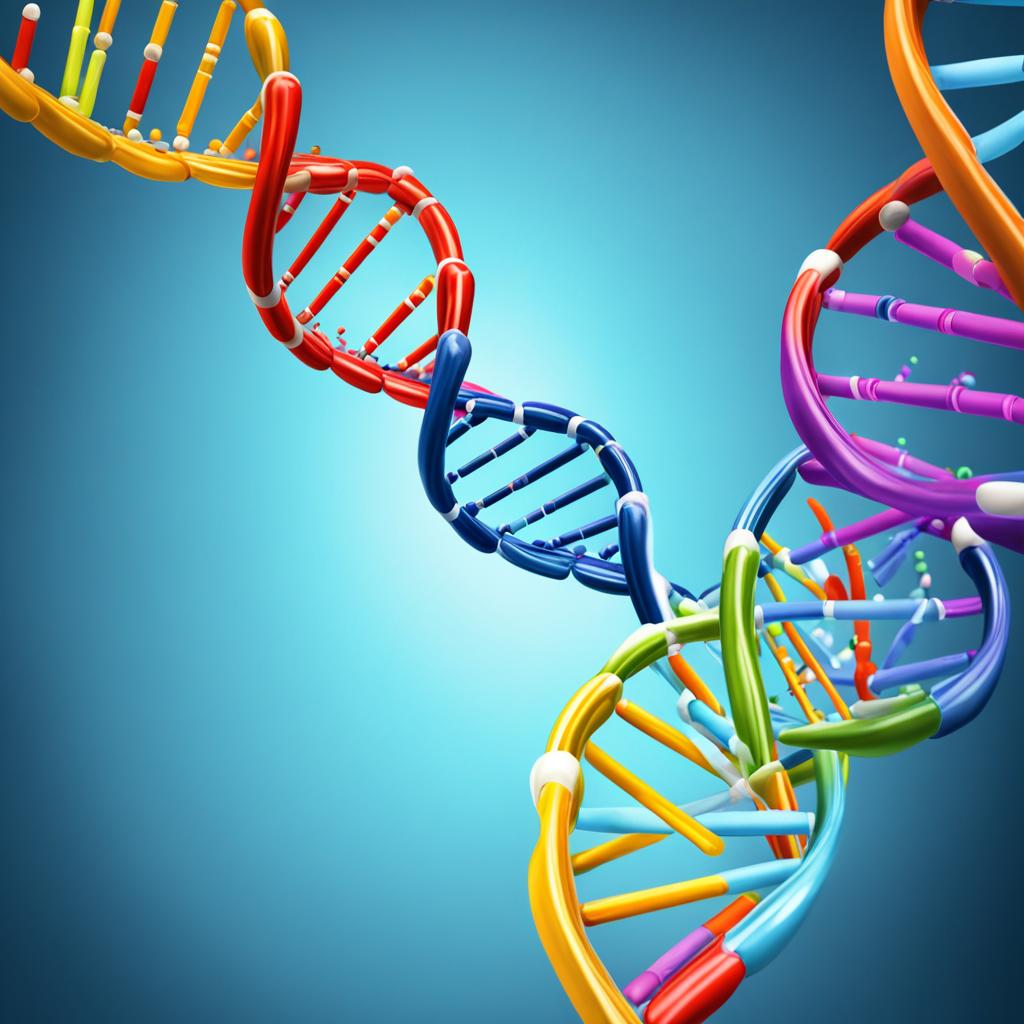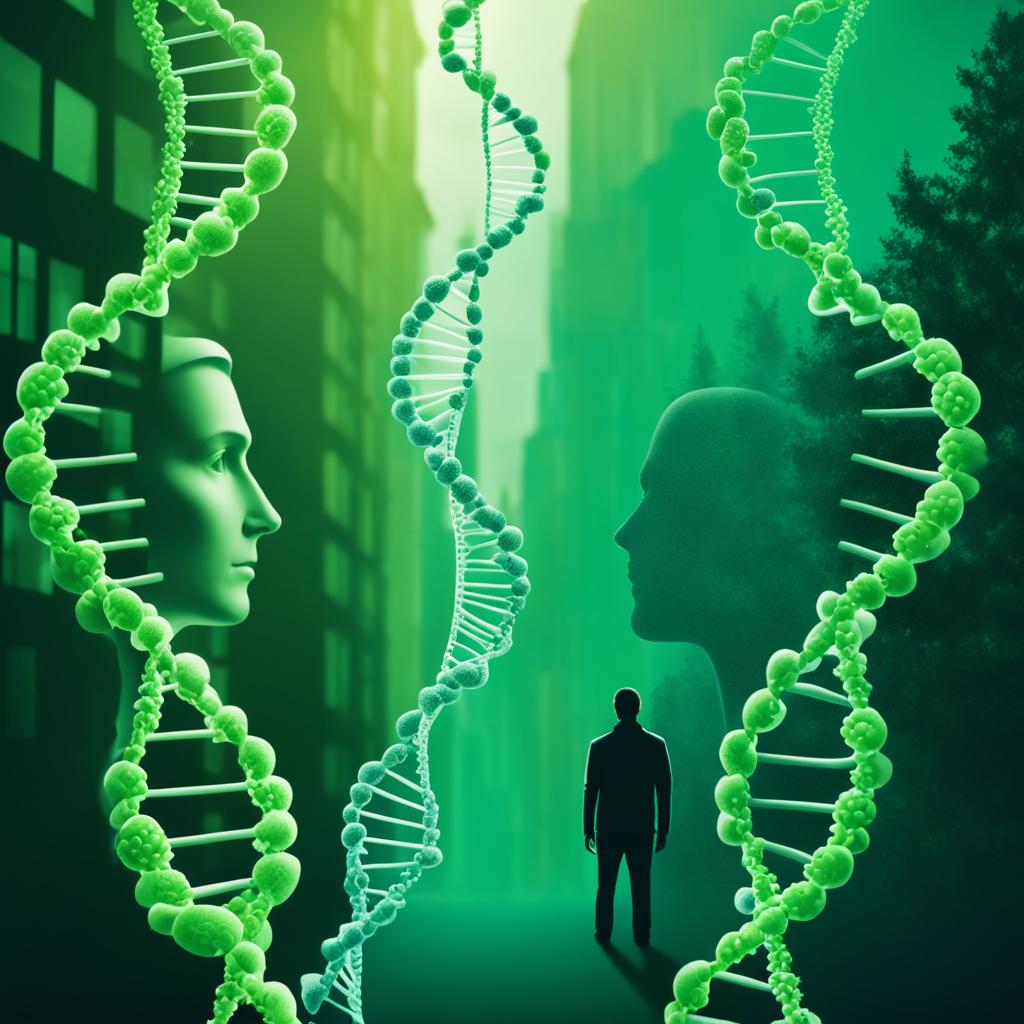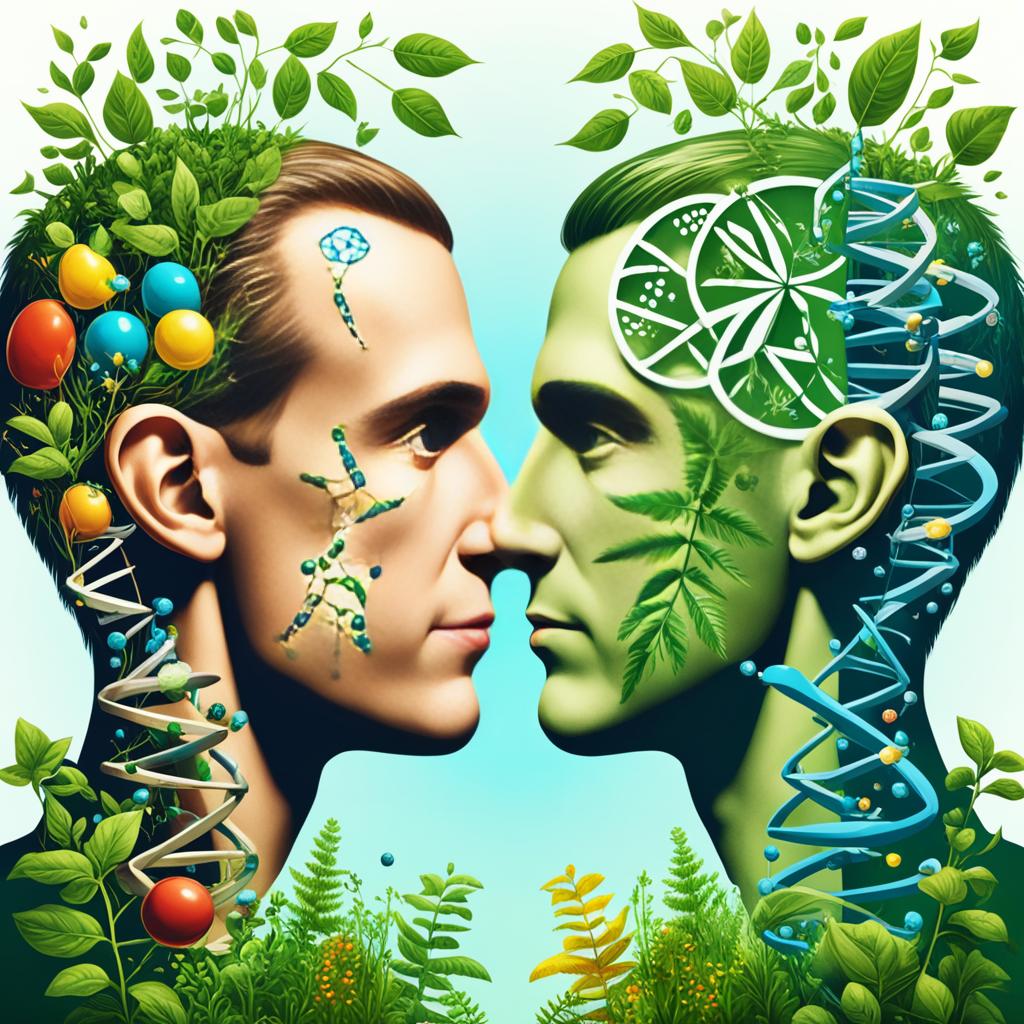Genetics affects about half of our intelligence. This shows how important genes are for how smart we are. They also impact our personality and can even affect mental health. By looking at how nature and nurture interact, we learn a lot about why we behave the way we do.
Genetics is all about genes and how they get passed down. It’s key to the growth and change of all living things. Mendel was the first to really look at it, back in the 1800s. His work set the stage for understanding how traits move from one generation to the next.
Our genes work with what we experience to shape us. This ongoing debate about what matters more – our biology or our life experiences – is the nature versus nurture debate. Our surroundings can affect how our genes work. This can then change how we are and how we act.
Scientists have used twins and adoption studies to look at this debate. They’ve found that twins who are exactly alike, raised separately, still turn out very similar. This points to genes as a big reason for our personalities. Also, our smarts seem to be mostly due to our genes. They could determine as much as 80% of how intelligent you are as an adult.
Introduction to Genetics
Genetics focuses on genes and how traits pass from parents to offspring. This science started with Gregor Mendel’s work in the 1800s. He studied pea plants to show how traits are inherited.
Definition and Scope of Genetics
Genetics studies genes, their variation, and how traits are passed on. It’s crucial for the life’s evolution. Genes are made of DNA and tell organisms how to grow and work. This includes everything from tiny cells to complex humans.
Historical Overview
Before Mendel, Imre Festetics used “genetic” describing heredity. But Mendel’s pea plant studies in 1866 defined how inheritance works. He showed how traits come from parents to their children. Mendel’s Laws explain these patterns.
| Key Genetic Concepts | Description |
|---|---|
| Eukaryotic genes | Found on chromosomes. Each chromosome has many genes. |
| Chromosome pairs | Most organisms, including humans, get two chromosome copies, one from each parent. |
| Meiosis | It creates eggs and sperm. Gametes have a single copy of each chromosome. |
| Genotype and phenotype | Genotype is your genetic info. This info affects your physical traits, or phenotype. |
Since Mendel, genetics has grown a lot. Now, we study how genes work and their role in health and behavior. Genetics helps reveal life’s mysteries. It teaches us about nature and where we fit in.


Foundations of Heredity
Gregor Mendel started the study of heredity in the 19th century. As an Augustinian friar and scientist, he looked into how pea plants passed traits on. He showed that certain traits follow simple rules.
Mendel’s Laws of Inheritance
Mendel found two key laws of inheritance by working with pea plants. The Law of Segregation says each gene copy from a parent separates. The Law of Independent Assortment tells us different traits pass on independently.
Chromosomes and Genes
After Mendel, scientists wanted to find the molecules behind inheritance. Thomas Hunt Morgan suggested genes sit on chromosomes. He saw this in a white eye mutation in fruit flies.
The human genome holds about 20,000 to 25,000 genes. These genes make up who we are. Things like mutations and polymorphisms create variation among us.


“The identification of DNA as the genetic material stemmed from studies in bacteria like Pneumococcus, where experiments showed that DNA played a pivotal role in transmitting genetic information, separate from proteins.”
Molecular Genetics
Molecular genetics has changed how we see life’s basic units. It looks into the DNA’s structure and role. This is the material that determines inherited traits in all life.
Researchers in this field cover many areas. They study things like brain growth control and how genes affect plant health.
DNA Structure and Function
DNA structure and function are key in molecular genetics. DNA carries the instructions for life. It was Watson, Crick, Franklin, and Wilkins who discovered its shape in 1953.
This revelation was crucial. It showed us how our traits are written in DNA. Now, scientists use the latest tools to learn even more about DNA.
“Genetics is now thoroughly molecular in contemporary science.”
This area has greatly grown. Scientists look at many organisms, from bacteria to mice. Their work helps in understanding diseases and how cells work.


Our knowledge in molecular genetics is always growing. We learn about important things like how brains develop and how plants fight diseases. This field is filled with chances for new findings and insights into life’s workings.
Genetics and Human Behavior
Genetics is key in how we behave, working with our surroundings. It impacts how our behavior shows based on our genes and what we’ve been through. This mix shapes our behavior in a big way, making the nature versus nurture debate quite rich.
Gene transcription at the start of gene expression can change, either up or down. This causes different behaviors, even in the same species based on their environment. For example, corn seeds from one variety grow differently in warm and dry places. This is because of how their surroundings affect them.
Many studies look at how genes affect what we do. For example, Plomin et al. (2001) did a big overview of how genes influence behavior. Evans et al. (2002) looked at the math side of genetics in psychology. Abrahamson et al. (2002) checked the role of genes and the world in our social thoughts, finding helpful numbers.
Twin and adoption studies really help. They show us what part genes and what part environment play in our behavior. Rhee and Waldman (2002) pulled together genetic and environmental info for antisocial behavior. This gave useful insights from these studies.
The world of genetics and human behavior is always growing. It’s becoming clearer how genes and our world shape our actions. Neiderhiser et al. (2004) looked at mom behaviors on teens, and Towers et al. (2001) studied how genes and our life at home affect us. These findings show how important this research area is.
To wrap up, genetics and human behavior research has come a long way. We’ve learned a lot about how our genes and experiences form our behavior. With more research, we’ll get even closer to understanding this link. That opens doors for personalized care in many fields, from health to social science.


Twin Studies and Behavior Genetics
Twin studies are a key tool in behavior genetics. They compare genetically identical twins to fraternal twins. This helps us see how much impact genetics and the environment have on behavior and personality.
Identical vs. Fraternal Twins
Identical twins share all their genes. Fraternal twins share about half. By looking at these twin types, we can figure out what parts of traits are from genes or from growing up together.
Findings from Twin Studies
These studies have given a lot of insight on genes and traits. For instance, traits like general intelligence are 50% to 80% heritable. Personality can be 20% to 50%. Even things we do, like voting, can be more than 50% due to genes.
These studies also show how the environment matters. Take height, for example. It’s 90% from genes but can vary a lot, like between North and South Koreans. This means what you experience can change how your genes show up.
The twin study method is great for figuring out why we’re like we are. It helps scientists look at everything from aggression to mental health. For example, we learn about how schizophrenia and addiction might work.
“The future of twin research involves combining traditional twin studies with molecular genetics research to identify specific individual genes contributing to heritability.”
As we keep learning, twin studies stay very important in behavior genetics. They show us the big mix between genes and our world in shaping who we are.


Genome and Heredity
After it was found that DNA carries our genetic information, scientists have learned a lot about us. The human genome is our entire set of genes, made up of about 3 billion base pairs. There are roughly 20,000 to 25,000 genes inside us.
The Human Genome
Research into the human genome has changed how we see human biology and illness. They think there might be between 61,000 to 140,000 genes in our genome. But, only 5% of DNA makes proteins. Many diseases and how the body reacts to things result from a mix of factors, not just genes.
Changes in gene sequences, called polymorphisms, can happen in at least 1% of people. These changes can really affect what our genes do. Different versions of genes, known as alleles, can change how proteins work, making each of us unique.
-ome is from a Greek word and it’s commonly used in genetics. For instance, the proteins in an organism are its proteome. Pharmacogenomics is another example, studying how our genes affect our reactions to drugs.
| Genetic Concept | Description |
|---|---|
| Polymorphism | Variations in gene sequences present at a frequency of at least 1% within a population, with potentially significant phenotypic consequences. |
| Alleles | Different versions of the same gene, which can affect protein activity and stability, contributing to individual differences. |
| Proteome | The complete set of proteins in an organism. |
| Pharmacogenomics | The study of how genes influence drug responses. |
Scientists have focused a lot on the human genome. Their work has led to big progress in many areas, from stem cells to tailor-made medicine. Understanding our genome helps us know more about human biology. This knowledge drives the development of new medical treatments.
“The human genome, the complete set of genetic information that defines us as a species, contains approximately 3 billion base pairs and 20,000 to 25,000 genes.”
Nature vs. Nurture Debate
The debate between nature and nurture has fascinated scientists for years. Some traits come from our genes, while our life experiences and how we grow up also shape us.
Evidence for Nature
Studies show that our genes can affect our behavior, pointing to a strong genetic influence. For example, they affect things like perfect pitch or how tall we are.
Epigenetics tells us how the environment changes our genes. This research connects genetics and the environment. It’s also found that certain illnesses, like autism, can have a genetic basis.
Evidence for Nurture
Psychologists say that outside things, like friends and social media, can strongly influence us. For children, learning by watching others is key to forming their behaviors.
The nature vs. nurture debate keeps going. Scientists are finding out more about how genes and the environment work together. It’s clear both are important in making us who we are.
| Genetic Influence (Nature) | Environmental Influence (Nurture) |
|---|---|
| Neurotransmitters affecting behavior | Peer pressure and social media impact |
| Traits like perfect pitch and height | Bandura’s social learning theory |
| Genetic predispositions to mental health conditions | Upbringing, socialization, and life experiences |
| Epigenetic modifications of gene expression | Interaction between genetics and environment |
“The impact of nature vs. nurture is evident in the development of mental illnesses such as schizophrenia, bipolar disorder, and ADHD.”
Genetics and Personalized Medicine
We are learning more about our genes and what they mean for our health. This has given rise to personalized medicine. This new field uses genetic testing to customize medical care for each person. It aims to make treatments more effective and improve patients’ outcomes.
Now, tests can check for 2,500 diseases, and babies get screened for genetic issues. Finding problems early with genetic testing stops them from developing. It also warns us about disease risks, like for type 2 diabetes, by looking at certain genes.
Our genes influence how drugs work in our bodies, affecting how we react to them. Pharmacogenomics studies these drug-gene interactions. People’s genetic differences can lead to unique drug reactions. For instance, some Caucasians with the TPMT*3A gene face a higher risk of severe drug side effects. So, they might need a different drug dose.
| Genetic Variation | Impact on Drug Response |
|---|---|
| TPMT*3A | Increased risk of life-threatening myelosuppression with standard doses of thiopurine drugs |
Research has linked certain genes to disorders like mental illness. This info helps in making medicine personalized. It lets us predict disease risks and adjust drug doses for better safety and effects.
Although personalized medicine shows a lot of promise, it still needs more work. There’s a need for more studies and trials to make it a regular part of healthcare. This way, we can make medical treatments even more effective and safe.
“Genetic testing has identified that specific genetic variations can lead to similar responses to treatments, affecting factors such as dosage required and risk of side effects.”
Conclusion
The study of genetics helps us understand how genes and the environment shape us. This means our traits and behavior come from both nature and nurture. The discussion between these two factors is important. But, we know they both play big roles in shaping us.
Genetics and genomics are also changing healthcare for the better. They let us personalize treatments to be more effective for each person. It’s key that we keep looking into the genetic side of health and behavior. But, we must do this while keeping ethics in mind.
Genetics has shown that there’s no one way to define biological races. This has led to more diverse research and a better understanding of human complexity. By using genetic knowledge in education, healthcare, and policy, we can help everyone. We aim for a future where everyone is treated fairly and equally.
Source Links
- https://www.ncbi.nlm.nih.gov/books/NBK225550/
- https://www.simplypsychology.org/naturevsnurture.html
- https://medium.com/@waliddesouky/the-role-of-genetics-in-human-behavior-nature-vs-nurture-e2c612527997
- https://bio.libretexts.org/Bookshelves/Introductory_and_General_Biology/Principles_of_Biology/02:_Chapter_2/19:_Genetics_-_Dog_Coat_Color/19.01:_Introduction_to_Genetics
- https://en.wikipedia.org/wiki/Introduction_to_genetics
- https://learn.genetics.utah.edu/content/basics/
- https://www.ncbi.nlm.nih.gov/books/NBK115568/
- https://www.ncbi.nlm.nih.gov/books/NBK9944/
- https://bio.libretexts.org/Bookshelves/Biochemistry/Fundamentals_of_Biochemistry_(Jakubowski_and_Flatt)/01:_Unit_I-_Structure_and_Catalysis/01:_The_Foundations_of_Biochemistry/1.04:_Genetic__Foundations
- https://biology.umbc.edu/research/molecular-biology-genetics/
- https://plato.stanford.edu/entries/molecular-genetics/
- https://www.fit.edu/programs/genomics-and-molecular-genetics-bs/
- https://www.ncbi.nlm.nih.gov/pmc/articles/PMC4685725/
- https://en.wikipedia.org/wiki/Human_behaviour_genetics
- https://thereader.mitpress.mit.edu/blaming-our-genes-the-heritability-of-behavior/
- https://www.ncbi.nlm.nih.gov/pmc/articles/PMC2899491/
- https://www.apa.org/monitor/apr04/second
- https://www.nature.com/articles/s41562-023-01609-6
- https://www.ncbi.nlm.nih.gov/books/NBK225676/
- https://www.genome.gov/about-genomics/fact-sheets/Genetics-vs-Genomics
- https://www.cdc.gov/genomics-and-health/about/index.html
- https://www.verywellmind.com/what-is-nature-versus-nurture-2795392
- https://michigantoday.umich.edu/2022/12/16/nature-vs-nurture-its-both/
- https://www.verywellhealth.com/nature-vs-nurture-5323408
- https://newsinhealth.nih.gov/2013/12/personalized-medicine
- https://www.nature.com/scitable/topicpage/pharmacogenomics-and-personalized-medicine-643
- https://www.news-medical.net/health/Genetic-Testing-and-Personalized-Medicines.aspx
- https://www.ncbi.nlm.nih.gov/books/NBK19932/
- https://www.ncbi.nlm.nih.gov/books/NBK62435/
- https://www.ashg.org/advocacy/genetics-in-society/
